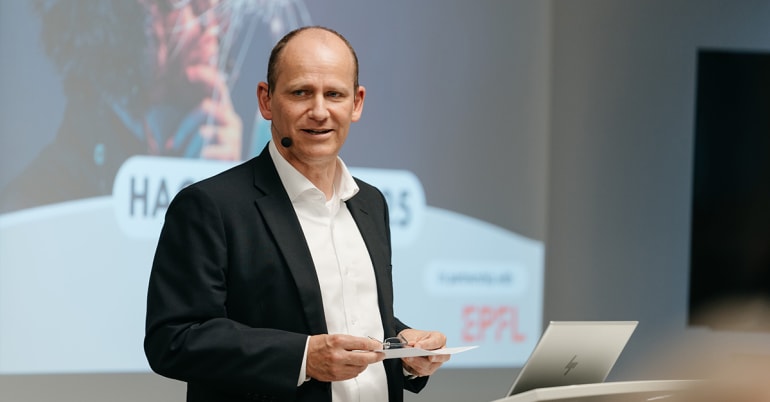Published in The Wall Street Journal on 25 June 2025
Financial institutions today face a challenging push-and-pull dilemma – regulators value caution and care, stability and predictability, while customers demand speed, high availability and new applications with the latest AI-powered capabilities. “Customers want the most innovative mobile banking applications,” says Jerry Silva, Vice President, IDC Financial Insights. “But if those applications go down and they can’t make a withdrawal, they’ll panic. Customers are really reliant on their services.”
While many financial institutions were early adopters of digital technology, decades of investment in legacy systems and applications can raise their own challenges, as technical debt – the cost of maintaining outdated and inefficient systems – can impede a company’s ability to satisfy customers and implement new technologies like generative AI. And modernising organisational technology, particularly in regulated industries like financial services, can be a major commitment.
“It’s not cheap to modernise data infrastructure, particularly at an institution that’s gone through decades of siloed applications and platform development, each with its own database,” Silva says. “You need to do a lot of work ahead of time, identifying why changes are necessary, auditing existing data files, asking about scale and understanding exactly what you want your data to be doing.”
To get there, he says, most organisations shouldn’t go at it alone. “Partnerships have become more critical than ever in every aspect.”
Modernisation at work
Lombard Odier is a 229-year-old Swiss private bank managing more than USD 390 billion in client assets. Like many venerable institutions, it needed to reassess its IT ecosystem. “Clients want interactions with the bank that are smooth and efficient,” says Geoffroy de Ridder, Head of Technology and Operations at Lombard Odier. “But our legacy infrastructure was driving a high level of complexity and operating costs, while limiting our capacity for change.” One example was its portfolio management system, which was originally built in the ’90s, with a very innovative caching mechanism at the time.
We decided to rewrite the application using the latest and most efficient technologies that would be the heart of our platform for decades
Some 30 years later, requirements had changed. Seeking a database platform with a flexible document model and a partner for broader application modernisation, the bank selected MongoDB. “We decided to rewrite the application using the latest and most efficient technologies that would be the heart of our platform for decades,” de Ridder says.
MongoDB leveraged its expertise in AI-powered applications to pioneer a software-driven modernisation strategy. This approach, which combines agentic AI orchestration, proven methodologies and expert engineering teams, accelerated the modernisation of the full application stack for Lombard Odier, resulting in quantifiable improvements. “Combining AI tools and our expertise allowed us to significantly accelerate code migration around 50 times faster compared to manual migration,” de Ridder says. “We can also perform code and database migrations in a single project, allowing us to reduce overall project times.”
Beyond the initial work on the portfolio management system, generative AI capabilities from MongoDB allowed Lombard Odier’s developers to accelerate the modernisation of 250 applications on a new generation of cloud-native application servers. Meanwhile, the speed of regression testing dropped from three days to three hours, ensuring migrations didn’t create instability.
With a modern infrastructure enhanced by new technologies, we’ve increased the satisfaction of our developers, who can focus on more value-added missions
“One of the most exciting parts of the MongoDB modernisation program is the ability to use it for multiple applications, which can significantly improve productivity,” de Ridder says. “With a modern infrastructure enhanced by new technologies, we’ve increased the satisfaction of our developers, who can focus on more value-added missions.”
Read also: Lombard Odier wins best technology outsourcing solution at the WealthBriefing European Awards 2025
Modernising and simplifying
Australia’s Bendigo Bank, with over 2.7 million customers, has long been a leader in digital banking. In order to serve its customers effectively, the bank needed to simplify and rearchitect its technology stack. Unsupported legacy applications like its Agent Delivery System, used in the bank’s agency locations, were among those hosted on premises and primed for innovation in this global first use case.
Recognising the need to modernise, Bendigo Bank replatformed and migrated the application to the cloud and its data to MongoDB Atlas. Working in partnership with the MongoDB team, it integrated AI into the modernisation process, automating elements of code generation and integration testing. This helped Bendigo Bank complete the migration to MongoDB Atlas both 90% faster and at one-tenth the cost of traditional cloud-to-cloud legacy migrations. By automating repetitive developer tasks, it reduced the time needed to run application test cases from over 80 hours to only five minutes.
With a modernised data infrastructure, the bank’s developers no longer have to support an inefficient legacy system, freeing them to focus on creating solutions to benefit customers.
“We wanted to prove that we could move faster, develop things in smaller chunks using a schema-agnostic database and make changes more quickly, with no outages,” says Dan Corboy, Lead Cloud Engineer at Bendigo Bank. “MongoDB Atlas supports the three major hyperscalers, which helps with portability and supports a multicloud future for us.”
For the first time, CIOs can transform their legacy applications into modern architectures in far less time and with much less risk than it used to take
Cedric Pech, President of Field Operations at MongoDB, says many companies in financial services face similar modernisation challenges due to “innovation stalled by decades-old technology, making it hard to focus on future-facing initiatives.” But every legacy environment is unique, he adds. “There’s no one-size-fits-all roadmap. We collaborate directly with customer teams to understand what success looks like for them, leveraging AI and the work of experienced engineers in a step-by-step process.
“For the first time, CIOs can transform their legacy applications into modern architectures in far less time and with much less risk than it used to take,” Pech says. “This frees up development teams to focus on building new features rather than on technical debt.” While he sees incorporating gen AI into a company’s modernisation journey as a force multiplier that can accelerate time to market, a critical prerequisite is a modern tech stack.
“Companies can only take advantage of the promise of AI if they have an underlying data model that thrives in handling unstructured data typical of LLMs,” he says. “Once modernised, those applications are scalable, secure and adaptable to change, which unlocks new business opportunities. Traditional, rigid relational data models just won’t cut it anymore.”
Implementing AI to reduce migration and testing costs should be on the agenda of most financial institutions
And Lombard Odier’s de Ridder believes many companies could benefit from a modernisation journey similar to the bank’s. Concerns about risk can be managed, and the opportunity costs of sticking with legacy platforms – forgoing innovation and efficiency gains for the future – are too significant to ignore.
“Implementing AI to reduce migration and testing costs should be on the agenda of most financial institutions,” he says. “An initiative like MongoDB’s modernisation program is important for reducing the cost of maintenance and migrations, and allowing the technology changes that will be key enablers for new benefits and business initiatives.”

This content was paid for by an advertiser and created by The Wall Street Journal advertising department. The Wall Street Journal news organization was not involved in the creation of this content.







share.